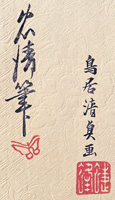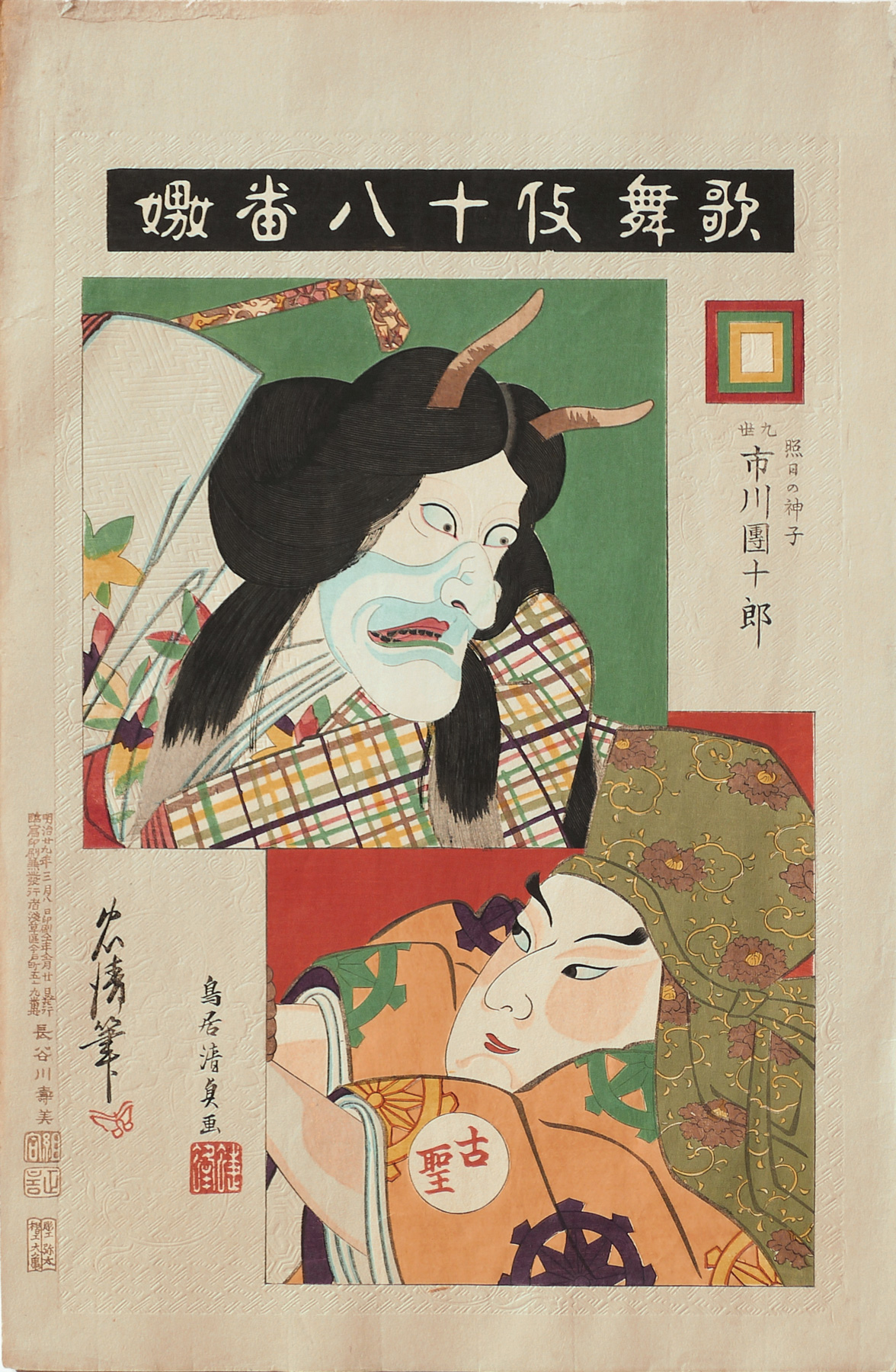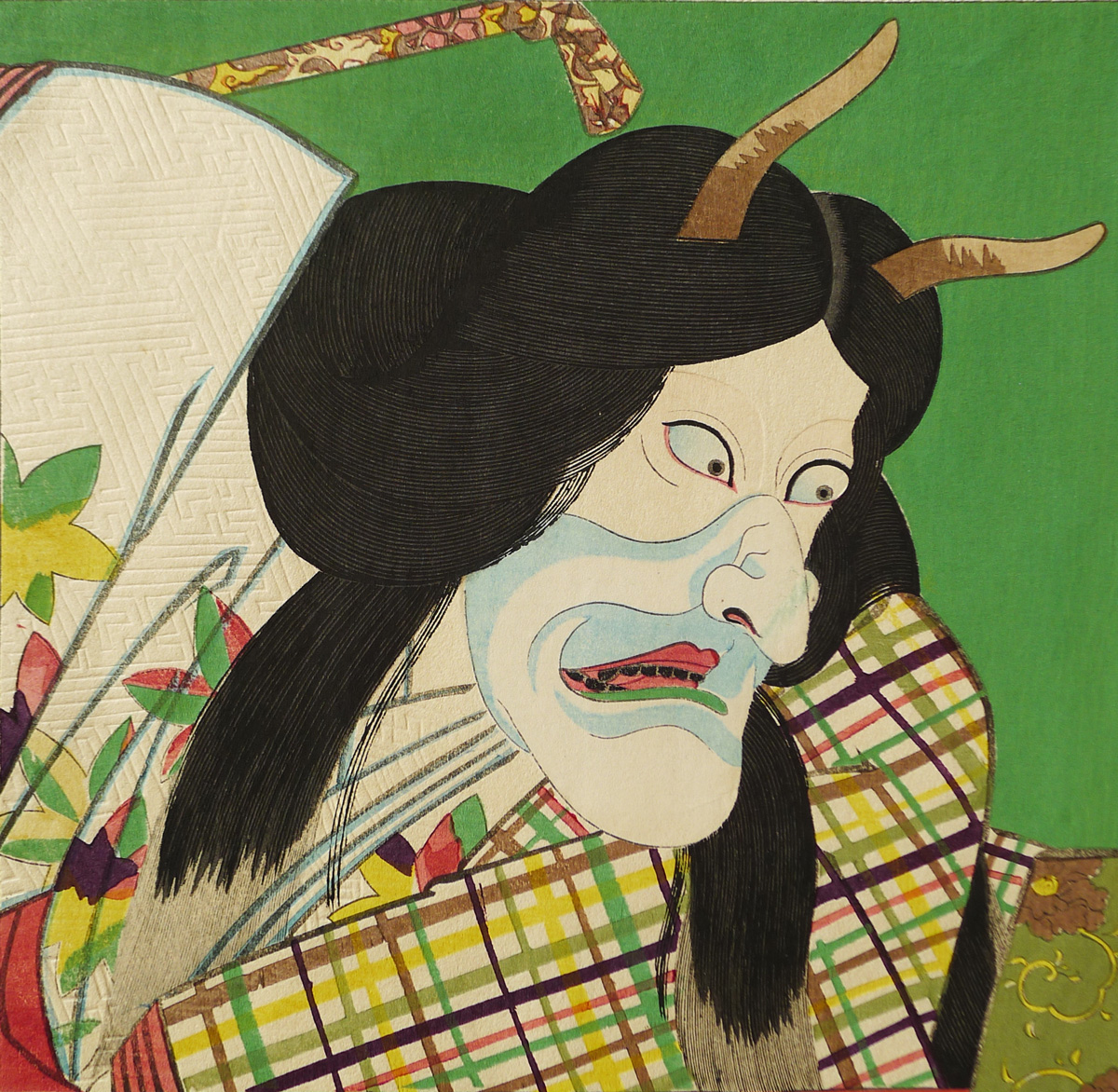About This Print
Ichikawa Danjūrō IX, in theupper left panel, playing the role of Teruhi no Miko 照日の神子 in the kabuki play Uwanari 嫐. He wears awhite hannya mask, denoting a vengeful femalespirit of aristocratic background. Below Danjūrō is an unidentifiedactor playing the role of Kishō 吉聖. The Ichikawa family crest (mon) of nested squares is shown to the right of Danjūrō.
As with all theprints in this series, there is extensive use of embossing both in the border areas and in the robes of Danjūrō.
The Play Uwanari
Variously translated as “The Mistress,” “The Second Wife,"“Jealousy,” and “Ambush of the Second Wife,” Uwanari was originally staged in 1699. While the original script has been lost, the play was re-written and re-staged in 1936 and is occasionally still performed in a re-written form, asin the case of a 2015 performance in Singapore headlined by Ebizo Ichikawa XI(b. 1977), the plot summary of which follows:
Uwanari, which means “second wife” and “jealousy”, is a torrid tale of jealousy, hate, and love. In it, a man divorces his wife and marries another woman. But while the newlyweds enjoy marital bliss, the jilted wife fumes, and plots her revenge on her ex-husband and the woman who replaced her. Passions will flare and dark schemes will bloom in this in riveting play, all told through impassioned dance.1
The Kabuki Eighteen
Source: Kabuki Encyclopedia, An English-Language Adaption of Kabuki Jiten, Samuel L. Leiter, Greenwood Press, 1979, p. 152."The Kabuki Eighteen," a collection of plays established by Ichikawa Danjūrō VII, stresses the special aragoto acting art of the Danjūrō line. In the Meiji period other acting families began to gather their most successful plays into similar collections. See the Title Page from the series The Kabuki Eighteen (Kabuki Juhachiban) for a list of the plays.
Print Details
| IHL Catalog | #1510 |
| Title or Description | Ichikawa Danjūrō IX as Teruhi no Miko in the play Uwanari 九卋市川団十郎 照日の神子 [嫐] |
| Series | The Kabuki Eighteen (Kabuki Jūhachiban) 歌舞伎十八番 |
| Artist | Torii Kiyosada (1844-1901) and Torii Kiyotada VII (1875-1941) |
| Signature |  left-most signature: Tadakiyo hitsu 忠清筆 followed by butterfly seal |
| Seal | as shown above: Chōhō seal right - butterfly seal left |
| Publication Date | February 28, 1896 (Meiji 29) 明治廿九年三月廿八 日 (as shown below under Publisher) |
| Publisher |  |
| Engraver |  摺工大亀 Surikō Ōkame |
| Printer | 摺工大亀 Surikō Ōkame as shown above |
| Impression | excellent |
| Colors | excellent |
| Condition | good - full size, light overall toning; paper abrasion along top margin |
| Genre | ukiyo-e; yakusha-e |
| Miscellaneous | embossing throughout |
| Format | vertical oban |
| H x W Paper | 14 1/2 x 10 in. (36.8 x 25.4 cm) |
| Literature | |
| Collections This Print | Museum of Fine Arts, Boston RES.53.17; Tokyo Metropolitan Library 5721-C008-05; Tsubouchi Memorial Theatre Museum of Waseda University 201-0194 and 201-0147 and 201-0167; Jordan Schnitzer Museum of Art, University of Oregon MWJ51:T109; National Gallery of Australia NGA 2015.627 |



